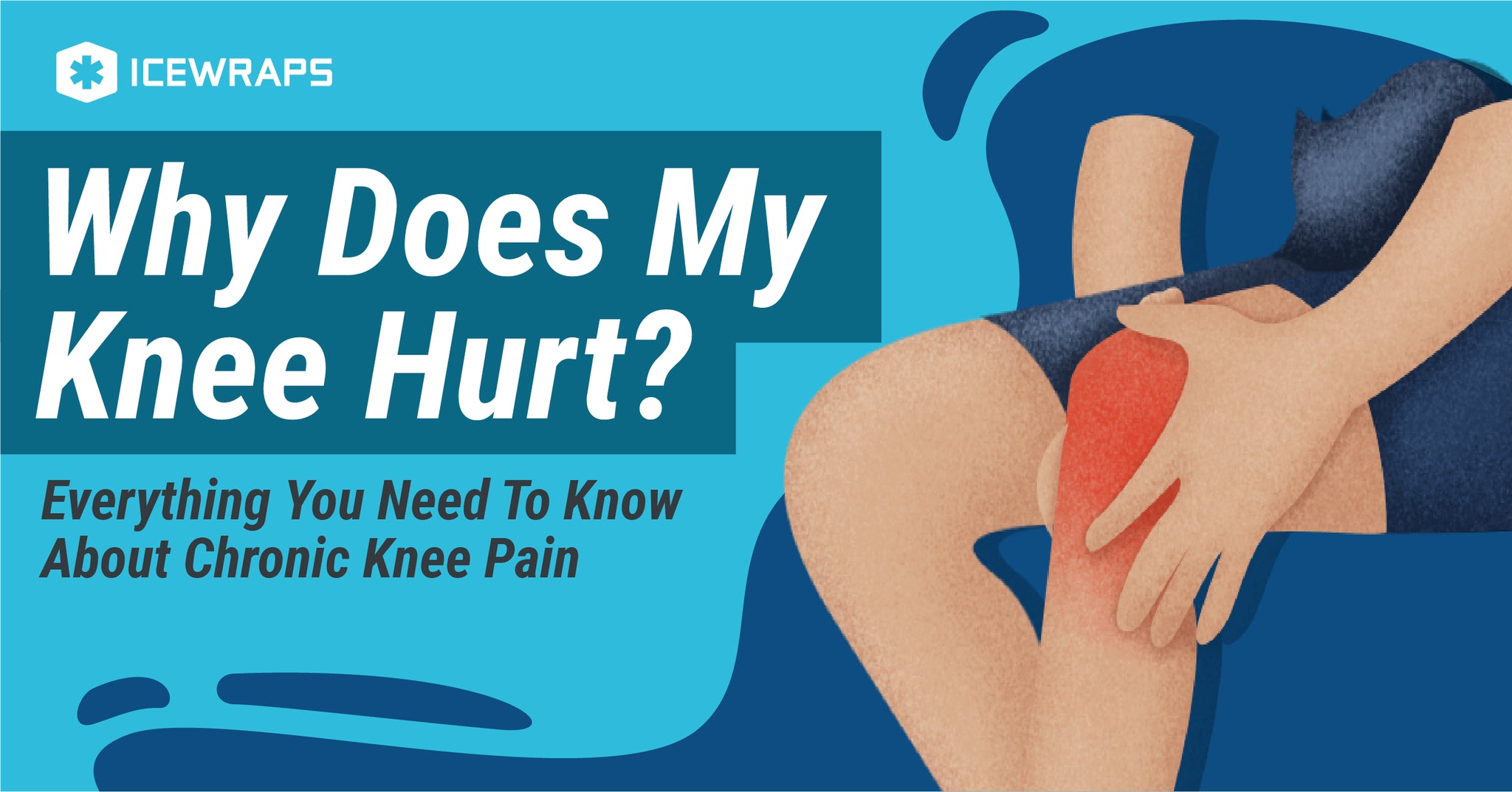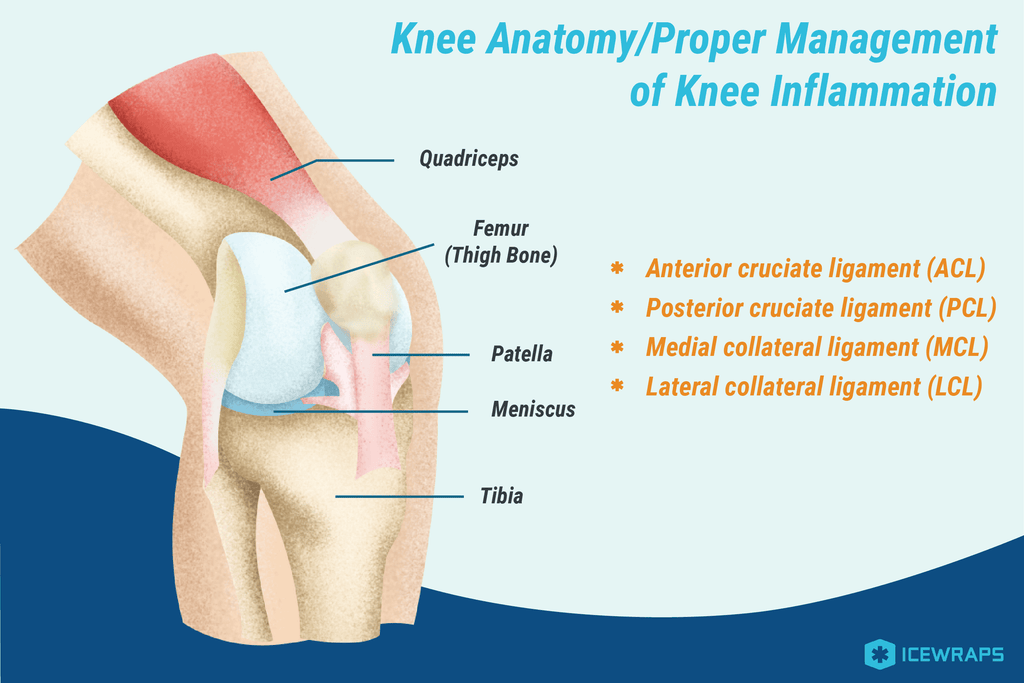Your Cart is Empty

Contents
Americans are no strangers to chronic knee pain. In fact, more than 15 million people suffer from chronic and severe joint pain in the States and a huge chunk of them are complaining of perpetually creaky knees.
What causes persistent pain on the inside of your knee and why does it not go away?
Are you doing something wrong?
Does exercise make knee pain worse?
And while we’re at it--- can the twinge in your knee really predict the weather?
If your joints were a basketball team, your knees would probably be the MVP.
Unlike the ball-and-socket shoulder joint, your knee is a hinge joint, which means it can only flex or extend in one direction. This anatomical feature makes your knees strong and stable. A large and complex network of ligaments and tendons also help stabilize the knee and improve its flexibility.
In addition, your knee joints are protected by the kneecap or patella. This triangular bone is capable of bearing a lot of weight, allowing you to lift, move, and even throw objects around.

But you know what they say, with great power comes...higher chances of wear and tear.
As the largest and the most complex joint in the body, your knee is responsible for bearing most of your weight and absorbing impact from your legs and feet during activities like walking, running, and jumping. If you do strenuous activities or high-impact sports that involve sudden changes in direction like basketball, football, and soccer, your knees and its supporting structures will suffer from a lot of stress and pressure, too. Add bad lifestyle choices, history of past injuries, and occupational hazards into the mix and it's not really hard to imagine why your knees are prone to chronic pain.
Contrary to popular belief, there’s no single cause for chronic knee pain. This condition can actually stem from a slew of factors and causes the following:
Physical trauma, like dislocations, fractures, and sprains, is one of the main villains when it comes to chronic knee pain. These incidents can be caused by a bad fall, a nasty sports injury, or a road accident to name a few.
Since your knee joint is made up of a lot of moving parts, the chances of injuring the bones, ligaments, cartilage, bursa, and tissues are particularly high. These injuries are not only painful; they can also leave lasting damage that can worsen as the person ages or engages in physical activity, even when they’ve completely healed. Take a torn ACL, for example. Lots of athletes who tear their anterior cruciate ligament (ACL) admit that they are never quite the same after even after surgical treatment and therapy.
Structural damage can also cause recurring injuries. For instance, people who have partially or fully dislocated their knees in the past have a higher risk for more dislocations in the future.
Chronic knee pain doesn't always stem from a single incident or injury. Oftentimes, it's caused by small, everyday activities that ultimately wear down your knee, like frequent lifting of heavy objects, playing high-impact sports, not stretching properly before a workout and the like.
When left unattended, chronic knee pain can lead to irreversible damage, a huge pile of medical bills, and a life full of discomfort, so it's important to prevent it before it's too late.
Make sure to observe the following tips to prevent chronic knee pain from taking over your life.
Regular exercise isn't only great for improving your cardiovascular health, it's also vital in strengthening your quad and hamstring muscles to avoid chronic knee pain. Strong muscles mean lesser chances of getting injured, even when doing high-impact activities.
Exercises also improve circulation and the flexibility of the tendons and ligaments supporting your knee joints. It helps you avoid lifestyle diseases like obesity, hypertension, and diabetes.
Already feeling a twinge of pain in your knees? Contrary to popular belief, you don't need to stop exercising when this occurs. Rather, you can try doing gentle, low-stress activities like swimming, walking, stationary cycling, or tai-chi to help your knees regain muscle and bone strength. If you’re unsure about which exercises to do, consult your doctor or physical therapist.
Foods that are high in purine like red meat, shellfish, and alcohol can contribute to the occurrence of gouty arthritis. Other foods put you at risk for inflammation, so make sure to be conscious of what you eat.
Stick to green leafy veggies like spinach, or fruits like grapes and berries to help fight inflammation and to get a healthy dose of vitamins and minerals like calcium and Vitamin D that are good for your bones.
Exercising without a proper warmup is just asking for an injury. A warm up slowly but surely prepares your body for exercise by gradually increasing your heart rate and improving the circulation in your muscles and joints. When your muscles are warmed up, they’re more flexible and are less stiff, preventing strains or overstretching.
You also have to make sure to do exercises in proper form. Engage the right muscle groups by being mindful of your posture and gait and never stretch your knee beyond its normal range of motion.
Take the necessary precautions to avoid accidents in your home or in your workplace. One simple way to do this is to stay organized. Make sure that your area is well-lit and free from clutter so you don’t fall or trip over random objects. Avoid falling by wiping up spills and messes immediately. If you have an elderly family member, make sure to install rails and anti-slip mats in your bathroom as a safety precaution.
Construction workers, movers, gardeners, and professional athletes put a lot of strain on their knees due to the nature of their jobs. It’s important for these individuals to rest their knees regularly and to take measures to slow down. If your knees take a beating on a regular basis, try icing them after an intense game or workout.
Chronic knee pain isn't something that you can just shrug off and bear with a grin. There are actually a lot of ways to combat the discomfort caused by chronic knee problems.
Here are some of them:
RICE, which stands for Rest, Ice, Compression and Elevation is extremely helpful if you've got a swollen knee or a pain flare-up. Cold temperature helps constrict your blood vessels, reducing swelling and nerve irritation. Make sure to use a reliable cold pack that evenly distributes the cold to your aching, swollen knee.
You can even combine the therapeutic effects of ice and compression by using a cold therapy knee wrap. This helps stabilize the knee joint while delivering the cold temperature evenly throughout your limb.
If your knee pain is caused by arthritis or some form of joint stiffness, then using a warm compress might be the way to go. Warmth dilates your blood vessels and facilitates better blood flow in the area. Hot therapy also loosens up stiff, bunched up muscles and promotes relaxation.
NEVER apply a warm compress when your knee is showing signs of swelling, though. To brush up on when to use hot or cold therapy, check out this blog post.
Exercises aren't just great for the prevention of knee pain; they're also a great treatment regimen. To keep your knee muscles strong and to lose the extra pounds, engage in gentle exercises that don't put a lot of strain on your knees such as swimming, water aerobics, and tai chi. You can also try the therapeutic exercises demonstrated on the video above.
 |
| ICEWRAPS 10X14 STANDARD COLD THERAPY CLAY PACK WITH COVER |
 |
The right footwear can reduce the strain from your knee and fight pain. Make sure that your shoes are of the correct size and are properly broken-in. Go for shoes with cushioned insoles to keep you comfortable.
Physical therapy or rehab is essential in strengthening muscles, improving balance, and maintaining your range of motion. Your physical therapist will conduct a thorough assessment to pin-point the exact cause of your knee pain and develop a plan of care to specifically cater to your needs.
Your physical therapist may prescribe exercises to strengthen your leg, thigh, and hip muscles such as quad sets, wall squats, leg lifts, and balance exercises. They may also teach you how to do these exercises and activities at home.
Over-the-counter pain medications like acetaminophen, ibuprofen, and naproxen help alleviate mild to moderate pain. For moderate to severe pain, your doctor may prescribe a more potent COX-2 inhibitor drug like Celecoxib, which has minimal gastrointestinal side effects compared to most non-steroidal anti-inflammatory drugs.
If your chronic pain is caused by gout or rheumatoid arthritis, you may be prescribed specific medications for those conditions as well.
When oral medications don't cut it anymore but you're still on the fence about getting knee surgery, your physician may opt for knee injections.
Knee injections are generally classified into two categories: hyaluronic acid supplement injections and corticosteroid injections.
Hyaluronic acid is a naturally occurring substance that helps lubricate your knee joints. People with arthritis usually have dangerously low levels of hyaluronic acid in their joints, so an injectable supplement is necessary. These are given regularly in a span of 3-5 weeks.
Corticosteroids, on the other hand, work the same way as cortisone, a hormone which helps reduce swelling. In most cases, only one injection does the trick but in others, it might need multiple sessions. One thing to note though is that while this type of injection offers pain relief, it also puts you at risk for cartilage damage.
If none of these conservative treatments work, you might need to undergo surgery to repair the parts that are causing inner knee pain.
One of the most common procedures done to correct chronic knee pain is knee replacement surgery. In this procedure, the damaged parts of your knee are replaced with plastic and metal components. Full recovery may take as long as 6 months, with many patients reporting decreased pain and improved motor function.
Knee arthroscopies are less invasive surgeries and are generally prescribed to repair meniscus tears, torn ligaments, and cartilage. In this procedure, the physician creates a small incision on your knee where they insert a thin tube with a camera at the end to visualize the joint. They also use arthroscopic instruments to repair the damage.
Your grandparents may have used their painful old knees to predict the weather at some point. Here's the truth: there's currently no scientific data to back up this phenomenon. However, many believe that knee pain during cold weather may be linked to changes in barometric pressure. Others think that staying indoors and participating in limited activities during colder days makes your joints stiff and achy. Whatever the real reason is, make sure to avoid knee pain altogether by following the tips mentioned in this article.
When left unattended, chronic knee pain can take over your life. The good news is there are a lot of ways to prevent and treat knee pain before it’s too late.
Are you experiencing knee pain? How do you manage it? Let us know in the comments below!
Comments will be approved before showing up.